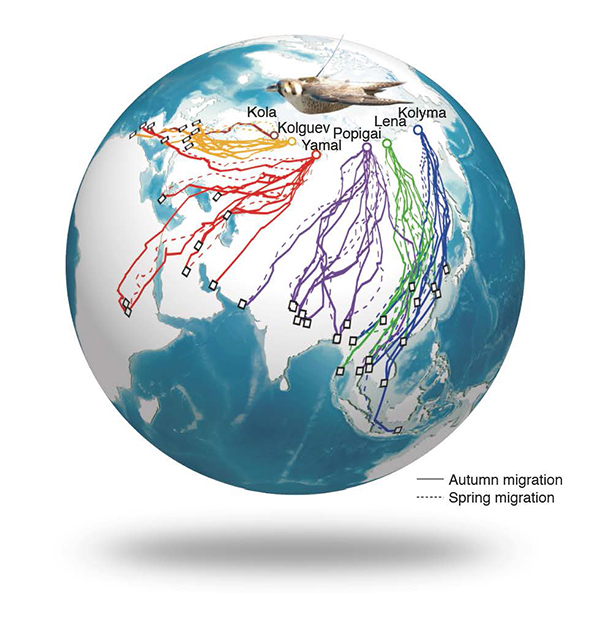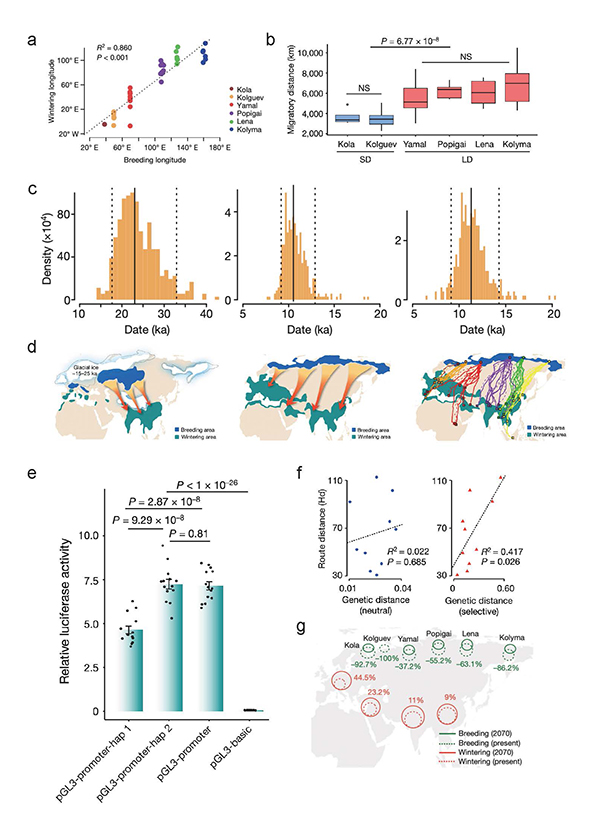Bird migration has puzzled us for centuries. At the global scale, about 19% of extant bird species are migratory and there are eight major flyways used by migratory birds (BirdLife 2010). Millions of birds fly almost the same routes to breeding/wintering grounds every year. However, up to date, we know little about the past formation, current maintenance, and future fate of these spectacular migration routes. At the same time, global climate change is now affecting many organisms and changing the dynamics of ecosystems from the tropics to polar regions. Bird migration, as one of the most complex and intriguing behavior adapted to climate, is certain to actively respond to climate change.
To address these issues, the research team led by Dr. Xiangjiang Zhan from the Institute of Zoology of the Chinese Academy of Sciences, published a study entitled “Climate-driven flyway changes and memory-based long-distance migration” in Nature on March 3th, 2021 (Gu et al., 2021). In the study, they integrated two state-of-art techniques, satellite telemetry tracking and whole genome sequencing, and established a continental-scale migration system of peregrine falcons (Falco peregrinus) in Eurasian Arctic.
Peregrine is one of the most successful top predators on Earth, with approximately eighteen subspecies distributed across six continents, except for Antarctica. The subspecies living in high latitudes are migratory. For this reason, the description “peregrine” alludes to the species’ “wandering”, or migratory behavior observed most strikingly in the species’ Arctic populations. Moreover, the first published reference genome for raptors was produced for the peregrine falcon (Zhan et al. 2013), which provides an opportunity to explore the species’ demographic history in depth. Thus, peregrines provide an ideal system to study the spatio-temporal dynamics of migration routes at a global scale.
To establish the migration system, the researchers tracked 56 peregrine falcons from six Eurasian Arctic breeding populations (Kola, Kolguev, Yamal, Popigai, Lena and Kolyma) and resequenced 35 genomes from four of these populations. They found the breeding populations used five migration routes across Eurasia, with high degree of migratory connectivity at both the population and individual levels. The five main migration routes across Eurasia, which is likely formed by longitudinal and latitudinal shifts in breeding grounds during the transition from the Last Glacial Maximum to the Holocene epoch.
A key prerequisite for the evolution of migratory routes is the existence of spatially heterogeneous environments, which generate heterogeneous selective pressures on birds migrating along them. In this study, the team found the contemporary environmental divergence among the routes appears to maintain their distinctiveness. More importantly, they quantified the migration strategies and found that migration distance is the most significant differentiation. Genomic analysis revealed that the gene ADCY8, which plays a role in long-term memory, is associated with this population-level difference in migratory distance. The researchers further predict that future global warming may cause peregrines in western Eurasian Arctic to change migration strategies and face more risks of population decline. They conclude that using ecological interactions and evolutionary processes to study climate-driven changes in migration could help facilitate the conservation of migratory birds.
This work is the first study elucidating the main factors-past, present and future- shaping the Arctic migration routes and identifies the key genes which may play an important role in determining the migration route length. It highlights the significance of integration of satellite telemetry, NGS genome sequencing and functional genomics with classical analyses in untangling an intriguing scientific question (formation and maintenance of migration route). Moreover, the elucidation of spatio-temporal changes along migration routes lays a cornerstone for conserving migratory species throughout their migration cycles in conjunction with ecological interactions and evolutionary processes.

Fig 1. The established migration system for peregrine falcons in Eurasian Arctic.

Fig 2. Past formation, present maintenance and future change of migration routes, and genetic basis for differences in migration distance.
References
BirdLife International (2010) The flyways concept can help coordinate global efforts to conserve migratory birds. Downloaded from http://www.birdlife.org on 11/02/2021.
Zhan, X., Pan, S., Wang, J., Dixon, A., He, J., Muller, M. G., ... & Bruford, M. W. (2013). Peregrine and saker falcon genome sequences provide insights into evolution of a predatory lifestyle. Nature Genetics, 45(5), 563-566.


